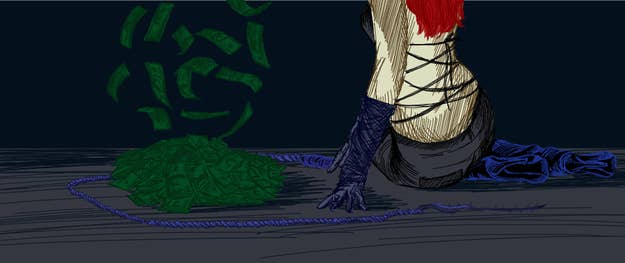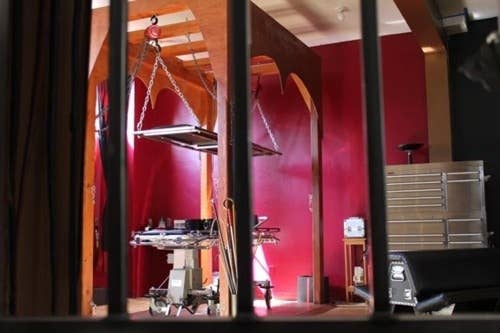
Madame Katorga* became a full-time dominatrix in the San Francisco area after cashing out as a dot-com executive at a startup during the first tech boom in the late ‘90s. A “high end” bondage practitioner, Kartorga’s clients at her East Bay dungeon come heavily from the tech world — older, “investor” types.
With moneyed male workers currently flooding Silicon Valley and San Francisco, one might think that Katorga’s business would be booming. But no. Thanks to the unusually tight-knit, helpful community of sex workers around the Bay Area, Katorga frequently talks to people all over the spectrum of bondage and escort — and they all say the same thing. Even though the Bay Area is the center of another global tech boom, no one feels very bubbly.
“A lot of what I glean from my lady friends is that they are not feeling busier in a big way,” Katorga said. “The average clients are less stressed, but when another Euro crisis hits, people are afraid to spend again.”

San Francisco has been a town of booms and busts since the Gold Rush, an era that established Baghdad-by-the-Bay as a vice palace. “Nearly all these women at home were streetwalkers of the cheapest sort, but out here, for only a few minutes, they ask a hundred times as much as they were used to getting in Paris,” said one observer. In the ‘70s, S.F. was the porn industry: It was one of the few places were smut could be legally shown and distributed. According to scholars and industry workers, the first tech boom (as well as the years following the bust), were very kind to sex workers of all stripes, from web video pioneers to strippers.
But recent interviews with a number of sex workers in SF indicate that while the tech industry might have come back strong, libertine excess and Veuve in the champagne room didn’t come back with it: The sex bubble went flat a while back and hasn’t yet rediscovered its mojo. Technology has disrupted porn to the point of unprofitability; current tech culture looks down on strip clubs; even upper-echelon dungeon masters like Madame Katorga haven’t been able to boost their prices. It has been a decade, she said, since her rates went up.
What is it about the social web culture that makes sex less sexxxy? Experts say piracy, the rise of amateur porn and the availability of free online networking are all leading factors, but things seem to go deeper than that. The current wave of start-up entrepreneurs seems personally less interested in pushing social mores: sex used to drive commercial online innovation, but that’s not true any more. And skittish new tech workers, scarred by the economic collapses of the past few years, are not spending big, at least anecdotally, on sex.
According to Melinda Chateauvert, a professor at University of Maryland who is writing a book about the history of sex work in America, the relationship between sex and tech has never been static — and current data demonstrates the disrupting power (ugh) of the internet. Typically, she said that in a bad economy, more women — who comprise the bulk of sex workers — go into the sex industry. In the past, it has been seen as a way to make good money quickly. “That was true in the 1930s, even in the recession of the 1950s, which people tend to forget,” she said. In the 2008 dip, though, she said that was not the case, perhaps because men were actually harder hit than women. Katorga’s experience confirms this: “People used to think that when the economy gets weak, this is a good business to get into. I don’t think that’s true any more.” Start-up costs are too high and there is too much competition from free services.
Another commonly held notion is that in a good economy, high-end goods always rise: “When there is money around, people spend money on luxury services and that is as true for hookers as dog walkers,” said Chateauvert.
But even at the high end, workers say that the current marketplace is only a little better than the previous few years —an uptick, not a wave. One key reason is that costs have risen disproportionately compared fees, for new spaces especially. “New spaces have quite a high overhead,” Katorga explained, noting that the expense of setting up a dungeon can run to $20,000. This is a problem because unlike the “Wild West” of the first tech boom, Katorga said that neither she nor her peers have been able to raise their kink rates for the last decade. “The economy is kind of a bludgeon on both sides — because guys are always hopeful that prices will go down,” she said.

This stands in sharp contrast to the heady times of the late ’90s tech boom. “The first one was when the internet became a way in which people met each other in serious way,” Katorga recalled. “There was an element of permissiveness, an element of excitement — suddenly, that stuff was not in the back of a seedy magazine, it was just out there.”
A former dancer at an S.F. strip club echoed those thoughts. “The golden age of stripping was the first tech boom,” she said. “The girls who worked there until around 2001 would be pissed if they didn’t take home $3,000 a shift. Now, I think they only get pissed if they make less than $1,000 a shift.”
It was also a different political time. “Eight years of liberal rule. It felt unregulated, unobserved — no one in Washington knew what was going on,” said Michael Stabile, a filmmaker and porn entrepreneur. “It you felt a little more like you were in on secret.”
According to Chateauvert, part of the reason S.F.’s sex scene bloomed in that time had to do with the big role porn and other vice services played in the tech boom in general — they were the early adopters. The first prostitution site popped up in 1994, the same year Playboy launched its website, which became the 11th most visited site on the Internet by 1997. And the promise of online video was seized on first by the porn industry, who managed to monetize “webcam girls” way before YouTube.
But profit didn’t happen overnight. Stabile, who worked at gay porn studio Naked Sword (a company that made Laura Croft game videos before looking for profits in porn) and creator of the “Wet Palms” series, said his porn career really took off after the dot com bust.
“The sex tech boom was 2004 to 2007, that was when things were really crazy. It was the equivalent of in the mainstream tech boom, companies that were overvalued,” he said. Many of the workers of the sex tech boom were refugees from the straight world: Porn was one of the few online businesses still making money. DVD sales were strong and porn stars like Jenna Jameson were the new celebrities, due in no small part to their huge online followings.
Web traffic was currency for sites looking to hook new customers. “There were so many crazy claims, ‘I can deliver you a million visitors,’ it was like buying drugs,” Stabile said. “I remember being at Internext, one of two big trade shows, in Florida at the Diplomat Hotel. I had a first generation iPhone and I remember being in a seminar on web traffic — how to get this magical stuff. I checked my phone and saw the stock market had plummeted. You could feel the sense of a bubble.”

Since then, other innovations have interrupted the sex world, both online and offline. Katorga pointed to the growth of online social networks, catering to every niche community imaginable, as a competitor to her business. If someone could log on to Fetish.Net, and find someone to administer a spanking for free, why would they pay for it? The whole professional porn industry is in crisis thanks to the availability of free amateur video sites. The excitement in the first tech boom around the possibilities of interconnectedness has now turned to a yawn.
Also, Katorga said that the culture around “no touch” sexual experiences — interacting (masturbating) with someone over video — has further damaged many sex workers’ business. Certainly, strip clubs are hurting thanks to the popularity of web cam: one local SF peepshow, the Lusty Lady, is approaching bankruptcy and making a last-ditch effort to incorporate video streaming into their website. How much revenue that will bring in remains uncertain.
And then there’s culture of the current tech boom. New York Times columnist Nick Bilton’s experience with caged tigers aside, many of the young tech workers coming to the city are living modestly. In a chat, Inspector Steven Ravelle of San Francisco Police Department said that he didn’t know of any link between the current tech boom and increased arrests for prostitution or other vice crimes, although he did say that technology had greatly changed the business mode of the world’s oldest profession: “Any level of prostitute has used the Internet at some point.” As one 2008 Ivy League grad working in IT told me, the experience of graduating into a recession was scarring — no one he knows goes to strip clubs for fun because they are constantly expecting layoffs. Tech CEOs might spend $15,000 on weekly get togethers but the tech workers pride themselves on productivity. The only growth sector that Katorga could point to were certain sites who do a “pay for play” model of a la carte porn, which serves those who don’t want to commit to pricey subscription plans.
Still, if any one can figure out how to make money from the current generation of tech millionaires, it would be sex workers. More than anything, Chateauvert said that the history of the sex industry is one of flexibility — both embracing and, at times, pioneering use of the technologies of the time. The classic example she cited was the growth in porn theaters during the ‘70s, an industry that went bankrupt when VHS and Beta made it possible to watch porn films in one’s homes. The porn industry obviously made the most out of that opportunity, shifting again to go online at the turn of the century. “That’s the dirty little secret,” she said, “The sex industry is usually the first one to figure out how to make money from new technology.”
Katorga hopes that she can start working with clients who value the efficiency of a professional relationship with a dominatrix over the amateur, social network experience. But she does admit to being worried about her dearth of new, young clients. “Do some young guys choose to play video games, jerk off to cheap porn and go to bed? Probably,” she said.
“I know a woman who’s been stripper for 17 years,” Katorga continued, noting that the woman “still looks amazing.” During dot com era, her friend made at least $5,000 a night. Now she’s lucky to make $500. “She does still make great money in certain places, like New Orleans,” she said, “but she can’t make shit here.”
Illustration by Chris Ritter for BuzzFeed
